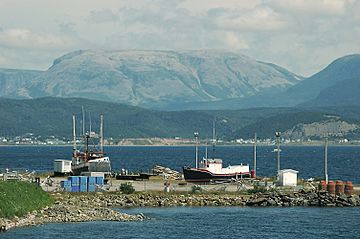Gros Morne (Newfoundland) facts for kids
Quick facts for kids Gros Morne |
|
|---|---|
 |
|
| Highest point | |
| Elevation | 807 m (2,648 ft) |
| Prominence | 707 m (2,320 ft) |
| Geography | |
| Parent range | Long Range Mountains |
| Topo map | NTS 012/H12 |
| Climbing | |
| Easiest route | class 2 scramble |
Gros Morne is a large mountain located in western Newfoundland, a province in Canada. It stands proudly near the small town of Rocky Harbour. This impressive mountain is part of the famous Gros Morne National Park, a place known for its amazing natural beauty.
At 807 meters (2,648 feet) tall, Gros Morne is the second highest peak on the island of Newfoundland. Only The Cabox is taller. The mountain is a popular spot for hikers and nature lovers. It offers incredible views of the surrounding landscape.
Contents
What is Gros Morne?
Gros Morne is a significant mountain within the Long Range Mountains range. This mountain range is actually the northernmost part of the Appalachian Mountains. The Appalachian Mountains stretch all the way down to the southern United States. Gros Morne stands out because of its unique flat-topped shape. It looks a bit like a giant table from a distance.
Where is Gros Morne Mountain?
Gros Morne Mountain is found on the west coast of Newfoundland. It is inside Gros Morne National Park. The park is a protected area that covers a huge amount of land. It includes coastlines, forests, and many lakes. The mountain is a central feature of this park.
How Tall is Gros Morne?
Gros Morne reaches an elevation of 807 meters (2,648 feet) above sea level. This makes it a challenging but rewarding climb for hikers. Its height allows for stunning panoramic views from the summit. On a clear day, you can see for many miles.
A Special Place: Gros Morne National Park
Gros Morne National Park is not just any park. It is a UNESCO World Heritage Site. This means it is recognized by the United Nations as a place of outstanding universal value. It is important for everyone in the world to protect it. The park got this special status because of its unique geology. It shows how the Earth's continents were formed.
Why is the Park So Unique?
The park is like an open-air textbook for geology. It has landscapes that show how plate tectonics work. Plate tectonics is the scientific idea that Earth's outer shell is made of large moving plates. These plates cause earthquakes and create mountains. In Gros Morne, you can see rocks that were once deep inside the Earth's mantle. This is very rare to see on the surface.
The Earth's Mantle on Display
Imagine the Earth like an onion with layers. The crust is the thin outer skin. Below that is the mantle, a much thicker layer. In Gros Morne National Park, especially in an area called the Tablelands, you can walk on rocks from the Earth's mantle. These rocks are usually found many kilometers deep. They were pushed to the surface millions of years ago when continents collided. This makes Gros Morne a truly special place for scientists and visitors alike.
Exploring Gros Morne Mountain
Hiking to the top of Gros Morne Mountain is a popular adventure. The trail is challenging but offers amazing rewards. It is a full-day hike that takes you through different types of landscapes. You will see forests, rocky slopes, and even a barren plateau at the top.
Hiking the Mountain Trail
The main trail to the summit is called the Gros Morne Mountain Trail. It is about 16 kilometers (10 miles) long round trip. The first part of the trail goes through a forest. Then, it climbs steeply up a rocky path. This part is often called the "Big Climb." Once you reach the top, you are on a flat, rocky plateau. From here, you can enjoy incredible views of the fjords and lakes below. It is important to be prepared for this hike. You should bring plenty of water, snacks, and warm clothing. The weather can change quickly on the mountain.
Animals and Plants of Gros Morne
Gros Morne National Park is home to a variety of wildlife and plants. The different landscapes, from coastal areas to high mountain plateaus, support many species.
- Animals: You might spot moose grazing in the lowlands. Caribou also live in the park, especially on the higher plateaus. Other animals include black bears, red foxes, and snowshoe hares. Many types of birds also live here.
- Plants: The lower parts of the mountain have forests of balsam fir and black spruce. As you go higher, the trees become smaller and more scattered. On the exposed plateau, you will find tough, low-growing plants. These plants are adapted to the harsh winds and cold temperatures. They include mosses, lichens, and small shrubs.
What Does "Gros Morne" Mean?
The name "Gros Morne" comes from the French language. "Gros" means "big" or "large." "Morne" is a term used in French to describe an isolated mountain or hill. So, "Gros Morne" roughly translates to "Big Lone Mountain." This name perfectly describes the mountain's appearance. It stands out as a prominent feature in the landscape.


